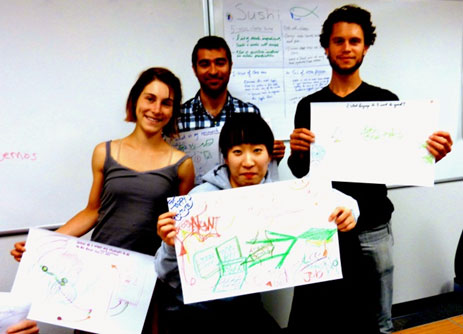“Creativity is as important in education as literacy, and we should treat it with the same status.”
-Sir Ken Robinson, “Schools Kill Creativity,” the #1 most watched TED talk to date
Using pipe cleaners to grasp calculus concepts. Being “bacteria detectives” to theorize about a microbe’s environment. UC Davis graduate students are coming up with clever techniques to teach undergraduates to think creatively in classrooms across the disciplines, thanks to a course developed and offered by the UC Davis Center for Excellence in Teaching and Learning (CETL).
While educational luminaries are increasingly recognizing the nurturing and developing of creativity as a critical, often neglected area in education, putting that value into practice has remained elusive. CETL is rising to the challenge by offering campus teaching assistants a class on “Teaching Creative Thinking in the Disciplines.” Developed and taught by Mikaela Huntzinger, Assistant Director and faculty developer, the seminar teaches a combination of theory and techniques to bring creative learning into their classrooms. The course has attracted TAs from programs as diverse as materials science, evolutionary biology, calculus, and law.
Before this class, I had thought of creativity as a sort of lightning strike or a Socratic daemon which visits you...
if you're lucky.
On a typical day in this unusual class, students arrive to find a densely packed lesson plan posted on the whiteboard, and a table full of enticing art supplies. Huntzinger maintains her students’ interest throughout the two-hour lesson with a lithe combination of creative learning activities—both individual and group—mixed with time for quiet reflection, all built on a solid theoretical framework.
Creativity: the Highest Order of Cognitive Activity
I visited the class on the day Huntzinger introduced Bloom’s Taxonomy of Learning, an iconic classification system of cognitive activities: remembering, understanding, applying, analyzing, evaluating, and creating. After describing the essence of each level, Huntzinger identified analyzing, evaluating and creating as “higher order” thinking skills. When a materials science postdoc questioned the difference between analyzing and evaluating prompted a lively discussion, a law student suggested that in his field, a crime is broken down into and act – which we can analyze by asking which part of a law was broken – and intent, which we can evaluate.
Huntzinger explained that each order of cognitive activity builds upon competency in the previous: “You can’t evaluate without analyzing. You can’t create with quality, without a capacity to evaluate the quality of what you’re creating,” she explained. Because of their cumulative nature, creativity education is concerned with all three of the higher-order skills. However, because some teachers and theorists believe mastery of the previous level is required, many classrooms never make it to the level of creativity – particularly when mastery is determined by standardized assessments focused on remembering, understanding, and applying.
Creativity as Synthesis
Huntzinger described creativity in opposition to analysis: it is a synthetic activity in which parts are assembled into a more meaningful whole, versus analysis, which is the breaking-down of a whole into constituent parts. This was a new concept for me – I had previously thought of creativity as a sort of lightning strike or a Socratic daemon which visits you, if you’re lucky.
After giving the class a quiet period to write about how these ideas fit into their own experiences, it was time to test the Bloom concepts in a small-group exercise in creative course design. Given a choice of three offbeat topics, each group was to develop a set of lesson plans, which had to incorporate creative thinking on the part of the students.

How to Teach Sushi
The different approaches presented by two groups that selected “sushi” as their teaching topic demonstrate the creative potential of the taxonomy’s framework: one group was craft-oriented, with lesson plans that included drawing and labeling the components of a piece of sushi; an “Iron Chef”-style competition; and learning how to catch and clean fish. The other group had an economic-geographical framework, with tasks such as mapping supply chains for different countries in which sushi is consumed, and inventing a “Davis Roll” featuring local ingredients.
The class concluded with the “rich picture,” an individual creative activity (finally, the art supplies!). On a large piece of paper, each student wrote down a work or life problem, and then drew about the problem, avoiding written words – generating expression from a different part of the brain, almost like dreaming. My picture addressed my complicated work flow. Above images of me doing various tasks with lots of arrows, to my surprise, my subconscious drew my boss’s smiling face in the corner, where a Kindergartener would put a happy sun.
Since attending this class, I’ve viewed creativity differently. Whether I’m interviewing an engineering student with a gift for fine arts, visiting a classroom which uses Lego cars as a springboard for designing a manufacturing line, or preparing a PowerPoint presentation, this new understanding illuminates my work. Thanks to CETL’s efforts, and the TAs who are dedicating time to this important endeavor, more and more undergraduates throughout the colleges may soon benefit from creativity in the classroom.
Think ![]() can't learn creativity?
can't learn creativity?
Think again.
